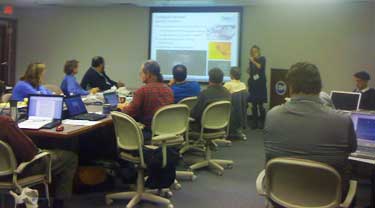Deep-C Study of Oil Spill in the Gulf Gets Underway

Members of the Deep-C Consortium gathered in Tallahassee on November 1-2, 2011 to discuss the group's goals and planned scope of work in support of the Gulf of Mexico Research Initiative (GoMRI). Deep-C is an interdisciplinary study of deep-sea-to-coast connectivity in the northeastern Gulf of Mexico.
By Tracy A. Ippolito, Deep-C Coordinator
November 2011 - Members of the Deep Sea to Coast Connectivity in the Eastern Gulf of Mexico (Deep-C) Consortium met recently in Tallahassee, Florida for the project's kick-off meeting, marking the beginning of a long-term study of the effects of the Deepwater Horizon oil spill in the Gulf of Mexico.
The Deep-C Consortium, led by Florida State University Professor and Director of the Center for Ocean-Atmospheric Prediction Studies (COAPS) Dr. Eric Chassignet, is an interdisciplinary study of deep-sea-to-coast connectivity in the northeastern Gulf of Mexico. Key questions to be addressed by this project relate to the magnitudes, directions, and spatial and temporal scales of hydrodynamic processes that transport particles and dissolved substances from the deep Gulf to the Florida Panhandle shelf waters in the northeastern Gulf of Mexico. In addition, Deep-C will investigate how the transport of these materials influence geochemical, biological, and demographic processes, including food web dynamics, across sea floor, pelagic, and near-shore ecosystems.

Dr. Kevin Speer (FSU) leads a discussion at the Kick-off Meeting about the Consortium's goals and objectives in the area of physical oceanography.
Representatives from each of the Deep-C member organizations were on hand to participate in the kick-off meeting presentations, breakout planning sessions and round-table discussions to further detail the consortium's planned scope of work for year 1 in five primary research areas: Ecology, Geochemistry, Geomorphology and Habitat Classification, Modeling, and Physical Oceanography. There were discussions about plans to provide real-life Deep-C research experiences for high school students, K-12 teachers, undergraduates, and graduate students as well as to communicate to the general public, legislators, and other policy makers the importance of Deep-C research in the Gulf as it relates to coastal ecosystems.
One of the most valuable aspects of the two-day event was the opportunity it provided for Deep-C members to engage in collegial discussions. The event also included a tour of the Ion Cyclotron Resonance (ICR) facilities located in the National High Magnetic Field Laboratory.
Deep-C was a four-year, interdisciplinary study of deep sea to coast connectivity in the northeastern Gulf of Mexico.Deep-C is no longer an active research project. The information on this website is for historical reference purposes only.
Home | About Us | Research Areas | Data Center | News & Multimedia | Education & Outreach
© Deep-C Consortium. All Rights Reserved.
This research was made possible by a grant fromThe Gulf of Mexico Research Initiative (GoMRI).
Copyright | Disclaimer | Privacy Policy
